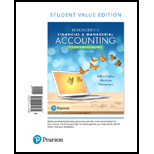
1.
Time value of money: Any amount invested today earns an additional income, called interest income, after a certain period. This is called as time value of money.
Present Value: The value of today’s amount expected to be paid or received in the future at a compound interest rate is called as present value.
Effective-interest amortization method: Effective-interest amortization method it is an amortization model that apportions the amount of bond discount or premium based on the market interest rate.
In this method, first, interest expense is calculated based on the current carrying amount and market interest rate and cash interest payment is calculated based on the face value amount and stated interest rate and then, the different between the cash interest payment and interest expense is amortized as a decrease to the discount or premium.
Amortization Schedule: An amortization schedule is a table that shows the details of each loan payment allocated between the principal amount and the overdue interest along with the beginning and ending balance of the loan. From the amortization schedule of the loan, the periodical interest expense, total interest expense and total payment made are known.
To calculate: The amount (present value) that company receive upon the issuance of the bonds payable.
2.
To prepare: An amortization table using the effective interest amortization method for the first two semiannual interest periods.
3.
To Journalize: Issuance of the bonds on January 1, 2018.
To Journalize: First semiannual interest payment and amortization of the bonds.
To Journalize: Second semiannual interest payment and amortization of the bonds.
Want to see the full answer?
Check out a sample textbook solution
Chapter 12 Solutions
Horngren's Financial & Managerial Accounting, The Managerial Chapters, Student Value Edition (6th Edition)
- In step acquisition accounting, what is the previously held interest? (a) Written off to reserves (b) Maintained at original cost (c) Ignored in consolidation (d) Remeasured to fair value MCQarrow_forwardPlease explain the solution to this financial accounting problem using the correct financial principles.arrow_forwardI want answer with all working formatarrow_forward
- Can you help me solve this general accounting question using the correct accounting procedures?arrow_forwardSolve with explanation and accounting questionarrow_forwardVito’s Veggie Rolls prepares 120 rolls every day and sells them at $19 per piece. For each roll, he spends $9.50 on raw materials. Additionally, he spends $1.10 for packing each roll and monthly $60, $20, and $15 for food cart rent, electricity, and other expenses respectively. Lost sales are considered to cost $1.50 per unhappy customer. Leftover rolls can be sold for $5.50 each. On a particular day in July, due to an unexpected strike, Vito was able to sell only 95 rolls. Assume there are 30 days in the month. Determine Vito’s profit for that day.arrow_forward

 AccountingAccountingISBN:9781337272094Author:WARREN, Carl S., Reeve, James M., Duchac, Jonathan E.Publisher:Cengage Learning,
AccountingAccountingISBN:9781337272094Author:WARREN, Carl S., Reeve, James M., Duchac, Jonathan E.Publisher:Cengage Learning, Accounting Information SystemsAccountingISBN:9781337619202Author:Hall, James A.Publisher:Cengage Learning,
Accounting Information SystemsAccountingISBN:9781337619202Author:Hall, James A.Publisher:Cengage Learning, Horngren's Cost Accounting: A Managerial Emphasis...AccountingISBN:9780134475585Author:Srikant M. Datar, Madhav V. RajanPublisher:PEARSON
Horngren's Cost Accounting: A Managerial Emphasis...AccountingISBN:9780134475585Author:Srikant M. Datar, Madhav V. RajanPublisher:PEARSON Intermediate AccountingAccountingISBN:9781259722660Author:J. David Spiceland, Mark W. Nelson, Wayne M ThomasPublisher:McGraw-Hill Education
Intermediate AccountingAccountingISBN:9781259722660Author:J. David Spiceland, Mark W. Nelson, Wayne M ThomasPublisher:McGraw-Hill Education Financial and Managerial AccountingAccountingISBN:9781259726705Author:John J Wild, Ken W. Shaw, Barbara Chiappetta Fundamental Accounting PrinciplesPublisher:McGraw-Hill Education
Financial and Managerial AccountingAccountingISBN:9781259726705Author:John J Wild, Ken W. Shaw, Barbara Chiappetta Fundamental Accounting PrinciplesPublisher:McGraw-Hill Education





